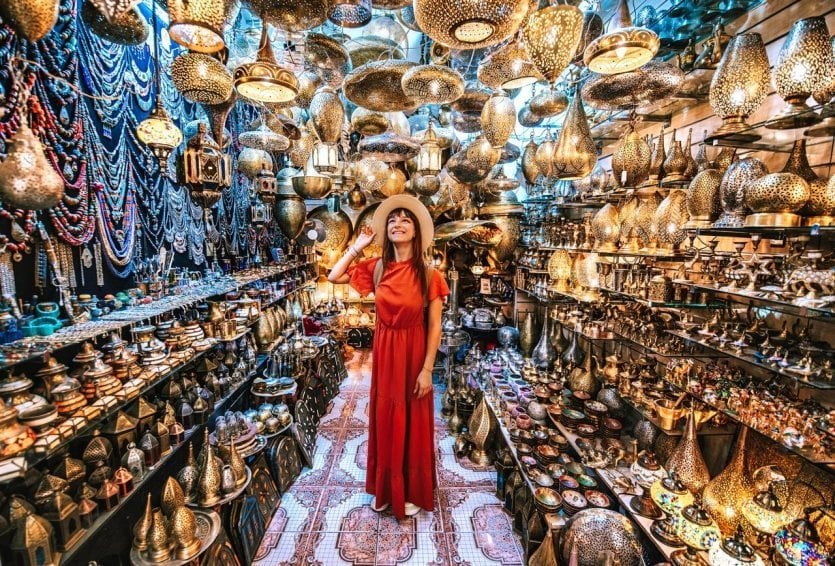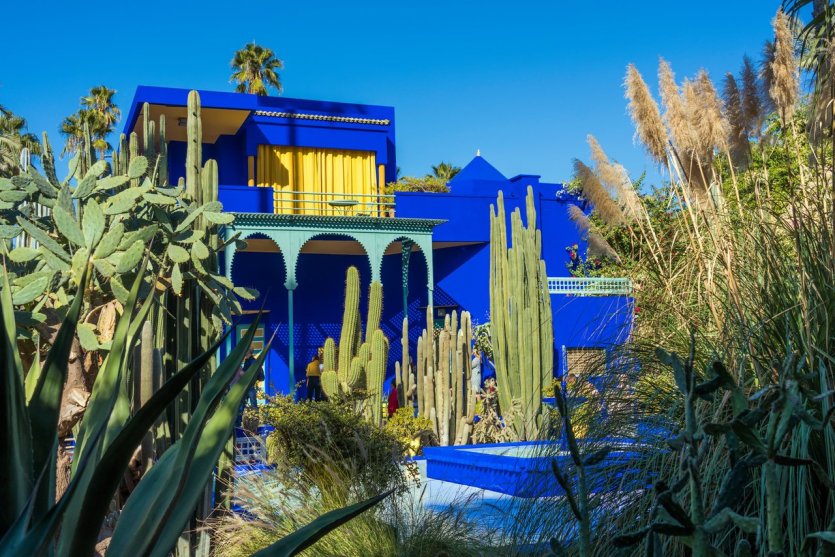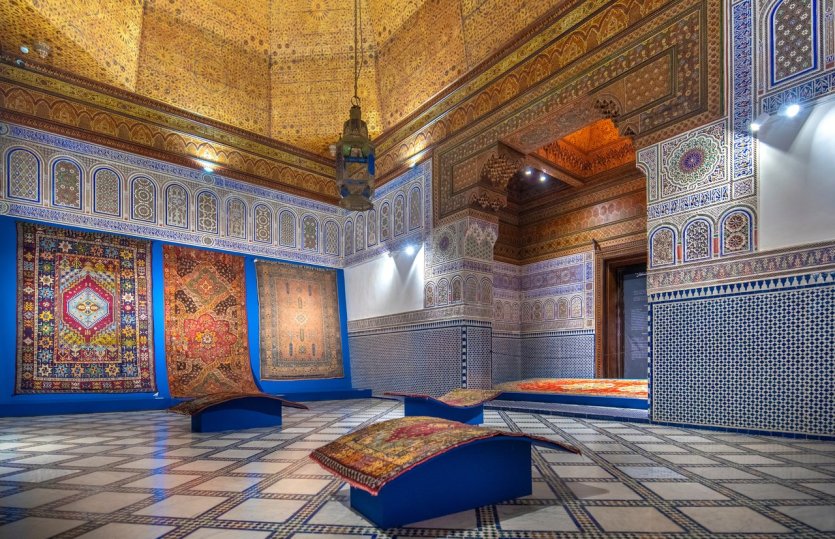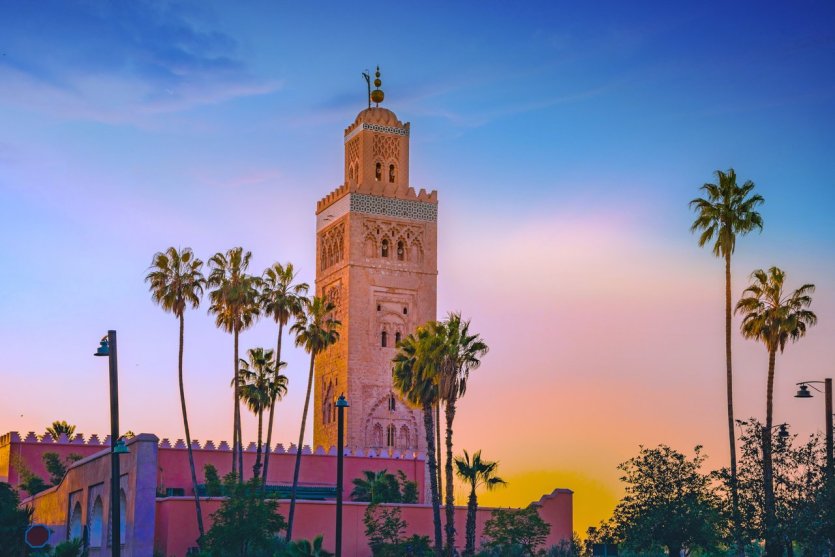
Nicknamed the "Pearl of the South", Marrakech is an enchanting city in Morocco, where history, culture and art merge in a kaleidoscope of colors and flavors. Are you lucky enough to spend three days here? Take advantage of the multitude of activities and discoveries offered by Marrakech, which will transport you to a world where East meets West. Whether you're a history buff, a food enthusiast, an architecture lover or simply looking for an exotic getaway, our guide will reveal the hidden treasures and must-sees of this fascinating city. Get ready to plunge into the heart of Marrakech and experience an emotionally-charged adventure, discovering its bustling souks, sumptuous palaces and vibrant atmosphere. Here's a detailed three-day itinerary with some of the best things to do in Marrakech, taking in the most iconic museums, mosques, palaces and cemeteries, as well as the Moroccan way of life for an unforgettable exploration of Marrakech. And if you want to avoid the crowds, schedule your trip from Monday to Wednesday.
Day 1: Visit iconic sites such as the Saadian Tombs, the Bahia Palace, the Jewish Cemetery and the Majorelle Garden.

For this first leg of our three-day exploration of Marrakech, we invite you to delve into the city's rich and varied past by visiting some of its iconic sites that bear witness to its past grandeur. Among the gems we'll discover are the mysterious Saadian Tombs, the sumptuous Bahia Palace, the peaceful Jewish Cemetery and the lush Majorelle Gardens, each of which offers a unique perspective on Marrakech's history and culture. It's time to get out and visit the mosques, palaces, ancient tombs and labyrinthine passageways.
- The Saadian Tombs
Located in the Kasbah district, Marrakech's Saadian Tombs are a hidden historical treasure. Built in the 16th century by Sultan Ahmed al-Mansur, they house the tombs of members of the Saadian dynasty (including Sultan Ahmad al-Mansur and his family). These mausoleums are adorned with superb stucco, ceramic tiles and delicate Arabic calligraphy. Closed for centuries, they were rediscovered in the early 20th century. Today, these tombs offer a fascinating glimpse of Islamic art and architecture from the Saadian period, and are a must-see for history buffs in Marrakech. A respectful attitude is required for this visit, as it is an emblem of Moroccan culture.
- The Palacio de la Bahía
The Palacio de la Bahía, or Bahia Palace, is a masterpiece of Islamic architecture located in the heart of Marrakech, Morocco. Built in the 19th century, it was originally intended to be the largest palace in the world. Although it never materialized, it remains one of Marrakech's main attractions and a dazzling testament to the opulence and refinement of the period. It features magnificent courtyards, lush gardens, carved wooden ceilings and colorful azulejos (earthenware tiles). The Palacio de la Bahía invites visitors to lose themselves in its enchanting corridors and discover Moroccan history and art in all its splendor. A must-see for those wishing to immerse themselves in the history and culture of Marrakech. In high season, it welcomes around 600,000 tourists a year, so expect queues and crowds. We therefore recommend a visit in June. at this time of year, the city enters the low season and many sites are virtually deserted.
The walk between Saadi's tombs and the Bahia Palace takes no more than fifteen minutes. If you're driving, you can get there in about four minutes via Derb Demnat.
- The Jewish Quarter
Marrakech's Jewish Quarter, known as the Mellah, is a historic gem nestled in the heart of the medina. Founded in the 16th century, it bears witness to the long Jewish presence in the red city. Its winding alleys, centuries-old synagogues, craft stores and traditional houses make it a place imbued with authenticity and charm . This district tells the story of the peaceful coexistence of different religious communities through the ages, and offers a captivating immersion in Moroccan Jewish culture. Here are just a few of the things you can see in the Jewish Quarter:
The synagogues of the Jewish Quarter: built around 1492, they now house ancient scrolls, Jewish candlesticks and tablets used by kings. The visit is entirely free, but we suggest you make a donation to the custodians.
The Jewish cemetery: here you'll find the remains of hundreds of Jews of different generations, whose contributions were fundamental to the enlightenment of the community. Today, visits are free of charge, but men must wear a kippah on their head. Failure to do so is considered a serious lack of respect.
To get from the Bahia Palace to the Jewish Quarter, you can choose to walk six minutes along Bahia Bab Mellah street. If you don't want to walk, you can get there in less than two minutes by car.
- Majorelle Garden
Located in the heart of Marrakech, the Majorelle Garden is an enchanting haven of peace amidst the hustle and bustle of the city, and has become an icon of the city. You can't leave Marrakech without visiting it. Designed by French painter Jacques Majorelle in the 1920s, the garden is a blend of bright colors, exotic plants and Moorish architecture . Majorelle blue, a distinctive hue, dominates the ensemble, creating a striking contrast with the lush vegetation. Acquired by Yves Saint Laurent and Pierre Bergé in 1980, the garden now houses a Berber museum and has become an emblematic symbol of Marrakech. It's a must-see for lovers of art, botany and tranquil beauty. Tickets for the Majorelle Garden start at 15 euros, but do not usually include a guide.
From the Jewish Quarter, you can get there by car via the P2006 road in around 15 minutes. Buses also leave from the Jamaa El Fna stop, but take around half an hour.
Day 2: A day in Marrakech's museums

In our three-day exploration of Marrakech, a day dedicated to art, culture and history is a must. The city, rich in tradition and heritage, is home to an impressive collection of museums offering a captivating journey through time and art. In this part of our itinerary, we invite you to discover Marrakech's cultural diversity by exploring its fascinating museums. From museums dedicated to Moroccan crafts, to institutions devoted to history and contemporary art, this day promises an enriching immersion in Marrakech's creativity and memory. Get ready for a day of unforgettable discoveries as we explore the museums of this enchanting Moroccan city.
- Yves Saint Laurent Museum
The Yves Saint Laurent Museum in Marrakech is an ode to fashion and art in the pearl of Morocco. Opened in 2017, the museum pays tribute to the famous fashion designer Yves Saint Laurent, who was deeply inspired by Marrakech throughout his career. The establishment houses an exceptional collection of haute couture garments, accessories, sketches and personal objects by the couturier. The museum's modern architecture contrasts magnificently with the majestic garden that surrounds it, creating a unique place for artistic contemplation. The Yves Saint Laurent Museum is a must-see destination for fashion enthusiasts, art lovers and anyone interested in discovering the lasting impact of this great designer on the fashion industry. Admission to the museum is around 7 euros.
- The Perfume Museum
Marrakech's Musée du Parfum is an enchanting place dedicated to the captivating art of perfumery. Located in the heart of the medina, the museum takes visitors on a fascinating olfactory journey through the history of perfume in Morocco. It features interactive exhibits that explore traditional perfume extraction techniques, highlighting precious Moroccan essences such as rose, orange blossom and musk. Visitors can also discover how traditional perfumes are created through live demonstrations. The Musée du Parfum is a unique sensory experience that explores the richness of Morocco's perfume culture. The visit is free, but if you can, we recommend you take a guided tour, which will give you a better understanding of how the machines and tools work.
The museum is located close to the Yves Saint Laurent museum, so you can combine the two visits and get there from the Yves Saint Laurent museum in around ten minutes; if you're driving, just take the Boulevard du 11-Janvier. Buses also leave from Club Ministre Justice or Alfa 2000.
- The Marrakech Museum
The Musée de Marrakech is a veritable cultural nugget nestled in the heart of the city's historic medina. Housed in a sumptuous 19th-century palace, the museum offers a journey back in time through Moroccan art, crafts and history. Visitors can admire an impressive collection of traditional artifacts, from Berber jewelry to sumptuous carpets, as well as temporary exhibitions highlighting contemporary Moroccan art. The museum's Moorish architecture is also an integral part of its charm, with interior courtyards adorned with finely sculpted mosaics and stucco. A visit to the Musée de Marrakech is an immersive plunge into the cultural and artistic wealth of Morocco. Ticket prices start from 3 euros (opt for a guided tour if you can!). Among the most important exhibits are collections of ceramics and objects handcrafted by Moroccan artisans.
The Musée du Parfum and the Musée de Marrakech are very close by, and can be reached on foot in just six minutes, via Rue Assouel and Derb Zaouiat Lahda.
- Dar Si Said Museum
Marrakech's oldest museum, the Dar Si Said, located in the heart of Marrakech's medina, is a real gem for art and culture lovers. Housed in a magnificent 19th-century palace, it offers an elegant setting for an impressive collection of traditional Moroccan objets d'art. Visitors can admire exquisite jewelry, sumptuous textiles, delicate pottery and much more, showcasing the country's refined craftsmanship. One of the museum's highlights isthe carved wooden ceiling room, an impressive example of Moroccan architecture. The Dar Si Said museum offers a fascinating insight into Moroccan craftsmanship and creativity through the ages. The museum is open daily, even on Sundays, and admission costs 8 euros per person.
Access from the Marrakech museum is easy: you can take a cab or drive along Rue Azbezt, arriving in about eight minutes.
- The Women's Museum
The Musée de la Femme in Marrakech is a unique venue dedicated to celebrating the role and history of women in Morocco. Set in a charming medina setting, the museum features a variety of exhibits that highlight the status, achievements and traditions of Moroccan women through the centuries. Collections include handicrafts, traditional clothing, historical photographs and contemporary works of art. The museum also offers educational programs and workshops to promote gender equality and raise awareness of the essential contributions of women to Moroccan society. It's an inspiring place to discover the richness of women's culture in Morocco. Admission to the museum is free, but you can leave a small contribution to support the development of the museum and the artists who exhibit there.
From Dar Si Said to the Musée de la Femme takes around eight minutes. We recommend that you search for it on your GPS, otherwise you won't find the exact location.
Day 3: Visit Marrakech's northern medina

In this stage of our three-day exploration of Marrakech, we invite you to delve into the heart of the northern medina, a veritable labyrinth of narrow streets, bustling markets and historic treasures . Every corner of this old city tells a story rich in tradition, culture and craftsmanship. Over the course of the day, we'll discover the hidden charms of the northern medina, from bustling souks to sumptuous palaces and tranquil gardens. You can visit the Madrasa de Ben Youssef, the Maison de la Photographie de Marrakech, the Secret Garden, the Kutubia Mosque and the Cyber Parc.
- The Ben Youssef Madrasa
The Madrasa Ben Youssef in Marrakech is a masterpiece of Islamic architecture that embodies the richness of Morocco's cultural heritage. Built in the 14thcentury , this former Koranic school (Marrakech's most important university school) is a magnificent example of Moorish art, with its mosaic courtyards, finely carved columns and chiselled wooden ceilings. For centuries, it was a renowned center of learning in the Islamic world. Today, visitors can explore its historic halls and admire the artistic details that testify to the importance of knowledge and spirituality in Moroccan culture. The Madrasa Ben Youssef is a must-see for those wishing to discover the splendor of Marrakech's architecture and history. You can visit it for less than a euro. Right next door, you can also visit the Ben Youssef Mosque.
- The House of Photography in Marrakech
The Maison de la photographie in Marrakech is a real treasure trove for lovers of visual art and photographic history. Housed in a beautifully renovated 19th-century riad, this institution is home to an impressive collection of early Moroccan photographs. Visitors can explore captivating images that trace the evolution of Moroccan life, culture and architecture over the decades. In addition to permanent exhibitions, the museum also features temporary exhibitions showcasing the work of contemporary photographers. The Maison de la photographie is a must-see for those wishing to delve into the visual and cultural history of Morocco. Don't miss "Photographic Treasures of Morocco", a permanent exhibition that transports you to the Marrakesh of 1870, with its social and cultural contrasts, as well as the picture of the month. In fact, each month a different painting is exhibited, usually encompassing Moroccan art. There'll be plenty of surprises in store, as each edition is dedicated to the discovery of new talent.
From the Madrasa Ben Youssef, it takes less than three minutes on foot, as it's just a few streets away. There's no need to take a cab or your own car.
- The Secret Garden
Le Jardin secret de Marrakech is an oasis of serenity nestled in the heart of Marrakech's bustling medina. This carefully restored historic garden offers visitors a peaceful, verdant escape from the hustle and bustle of the city. With its lush gardens, elegant fountains, magnificent architectural structures and Islamic design elements, the Secret Garden is a true celebration of Moroccan garden art. Visitors can stroll through its shady alleys, admire the beauty of the local flora and enjoy panoramic views of the medina from its towers. It's an ideal place to relax, recharge your batteries and discover the harmony between nature and architecture in Moroccan culture. Along the way, you'll see a restored palace. An ideal contemplative stop-off if you love nature and plants. To find out more about this area, you can visit the open-air museum, which features informative exhibits.
The Secret Garden is an eight-minute walk from the House of Photography, a three-minute drive away. Buses will drop you off in front of the Maison de la Photographie.
- Kutubia Mosque
The Kutubia Mosque is one of Marrakech's most emblematic icons, its majestic silhouette dominating the city's skyline. Built in the 12th century, this mosque is a masterpiece of Almohad architecture, featuring an ochre sandstone minaret almost 70 meters high . The Kutubia Mosque is not only a place of worship, but also a historical and cultural symbol of the city. Its minaret inspired the design of the Giralda in Seville, Spain. Although access to the interior of the mosque is restricted to Muslims, visitors can admire its architectural beauty from the outside and stroll through its peaceful gardens. It's a must-see for anyone visiting Marrakech.
To get to the last stop, we recommend you walk from the Secret Garden to the Kutubia Mosque, along Rue Sidi el Yamani. The journey takes less than eight minutes, but there are also bus routes and horse-drawn carriage rides.
- Taste Marrakech's gastronomy
During your three-day getaway to Marrakech, you absolutely must try Moroccan cuisine, a combination of savory and sweet flavors: fragrant tajines, fluffy couscous, grilled brochettes, crispy pastillas... All spiced up with bewitching blends of ras-el-hanout and cumin. The bustling markets abound with sweet delights, from pastries to mille-feuilles to Medjool dates, not forgetting refreshingmint tea. Each dish is an explosion of flavors, combining the authenticity of Moroccan traditions with a touch of modernity.
Tips for visiting Marrakech for the first time
If this is your first time in Marrakech, don't be afraid! It's a charming city that will welcome you with open arms, and where the locals are very friendly. To make your visit easier, here are our top tips for visiting Marrakech.
- Respect traditional dress
Marrakech has its own particular traditions, as it is a conservative country. For each gender there are basic recommendations that we recommend you follow for a pleasant and trouble-free trip. Women should mainly cover their shoulders and legs, and avoid wearing clothes that are too short or tight-fitting, preferring instead long skirts, pants and tunics that cover shoulders and knees. Veils are also required to enter mosques. Men are also invited to respect these instructions by wearing pants and shirts with short or long sleeves, and to wear a yarmulke when entering certain Moroccan compounds.
- Learning your way around the city
If you're spending three days in the city, you'll probably want to know how to get around Marrakech. In general, it's a small city that's easy to get around on foot. The only thing you need to be aware of is the highway code. When walking, you should always head in the right direction, or simply follow the flow of pedestrians. There are practical options such as private transfers, cars and cabs. However, to experience Moroccan culture, we recommend venturing out on a horse-drawn carriage ride. There's no set price, so you'll have to haggle. If you still prefer traditional transport, here are your options:
- Bicycle hire: as soon as you arrive in Marrakech from the airport, you'll find that there are plenty of fast, environmentally-friendly means of transport. Bicycles let you avoid the traffic, as you can weave in and out of cars. Of course, you'll need to take care when riding through this bustling city.
- Marrakech sightseeing bus: The Marrakech sightseeing bus is a mode of transport that offers both the historical tour and the palm grove tour. Both are comprehensive options that offer free stops so you can explore at your own pace.
- Public bus: Marrakech's public transport system is very comprehensive, as it is perfectly interconnected. Be aware that vehicles are often in poor condition and many tourists prefer not to use them.
- Cabs: Taxis are an accessible and relatively inexpensive option compared with fares in other parts of the world. Authorized cars can be identified by their license plates and taximeters. avoid informal drivers, who represent a risk to tourists.
- Stay in safe areas
Before you head off to this Moroccan destination, you may want to find out more about safety in Marrakech. Generally speaking, you have nothing to worry about. The city is quite safe, and the locals are welcoming to tourists. The least recommended areas are the dark alleys of the medina. It's also not advisable to visit the Jewish Quarter at night. In particular, avoid the Al-Azzouzia district, where robberies are reported at all hours. Also, don't give out your personal details to strangers, and watch out for pickpockets. You'll also be approached by bogus professional guides; remember that a travel agent will never approach you on the street. It's up to you to book online, on an authorized site. Don't travel alone, and if you do decide to do so, hire guided experiences while you familiarize yourself with the city.


